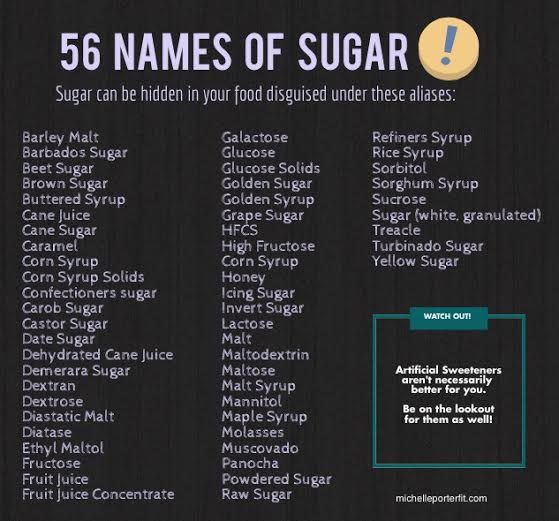Diet culture would have us believe that “sugar is evil” which is not accurate to the degree that diet culture messaging would have us believe. But there is something we need to be aware of and share with our clients: added sugars are hiding in plain sight.
Sugar is not evil nor is it, alone, going to cause weight gain by allowing some of it into your diet; however, the presence of so much added sugar in American food products is problematic. Clients may have the best of intentions of limiting the sweet stuff but are unknowingly consuming far greater amounts because sugar is not just called “sugar” in an ingredient list.
The nutrition facts panel does list “added sugars” under the Total Carbohydrate section, but it is difficult for consumers to visualize what, for example, three grams of added sugar looks like or equates to. Likewise, they may not be evaluating the ingredient list thoroughly because they aren’t aware of the various names of sugar and how it is often veiled on an ingredient list.
Consequences of Sugar Overconsumption
Fat Storage
Sugar is an ingredient that can make something taste so good (no denying that). Most people know that high sugar consumption should be avoided for general health, however, fewer people know that sugar can be one of the biggest obstacles keeping clients from reaching their goals. Consuming high amounts of added sugar leads to dysregulation of lipid and carbohydrate metabolism. In other words, it can lead the body to promote fat stores and weight gain making the hours put in at the gym much less effective in losing weight.
Nutrient Depletion
While some clients might not have an issue with weight, sugar can still be impacting their athletic goals. Many vitamin, mineral, and hormone deficiencies can be responsible for dysfunction in the body leading to weight gain or decreased athletic performance. As it turns out, sugar can be responsible for these deficiencies.
Overconsuming added sugar depletes the body of its stores of vitamins and minerals. Common sources of added sugar like sugar cane, beets, and corn go through refining processes that leave the sugar with zero nutritional value. That means it contains no protein, fat, fiber, or enzymes that are essential for your body to digest and use the sugar. Since the added sugars contain none of what your body needs to metabolize the incomplete food, your body must borrow vital nutrients from healthy cells to make use of the sugar.
Short & Long Term Effects of Sugar Overconsumption
In the short term, this can reduce athletic performance by drawing minerals such as calcium, magnesium, potassium, and sodium from cells all over the body. Sodium and potassium, in particular, are known to be crucial in maintaining proper hydration. Excess sugar can throw off the balance and lead to dehydration; symptoms such as cramping and heat injuries during exercise are more likely.
Long-term effects of this constant depletion of minerals from healthy cells can cause an increased risk for chronic disease (diabetes, heart disease, thyroid disease, etc.) which in turn, can even further impact athletic performance, if preventing chronic disease isn’t motivation enough.
Sources of Added Sugar
As previously mentioned, virtually all processed food contains added sugar in some form even if the ingredients don’t list it as plainly as the work “sugar”. Added sugar can be labeled using many different names that many of us don’t recognize. In fact, there are over 50 different names for added sugar! Here is a graphic and some extras not on the list you can use to familiarize yourself with all the sources:

Basic Simple Sugars (monosaccharides and disaccharides):
- Anhydrous dextrose
- Cane juice crystals
- Castor sugar
- Coconut sugar
- Corn syrup solids
- Crystalline fructose
- Florida crystals
- Panela sugar
- Sucanat
Liquid or Syrup Sugars:
- Agave Nectar/Syrup
- Barley malt
- Blackstrap molasses
- Brown rice syrup
- Buttercream
- Evaporated cane juice
- Nectar
- Pancake syrup
This list encompasses the most common forms of sugar found in food products ranging from canned, frozen, boxed, bagged, and baked goods. One rule to share with clients – if it has an “-ose” on the end of the word in the ingredients list, it’s some form of sugar.
This is not, however, a message to “avoid” or cut out the sweetness in life. The overarching message here is to help clients learn to identify all the sources of added sugar they are quietly consuming. You may explain how the recommended sugar consumption for one day translates. We want to encourage clients to keep their intake of sugar to less than 10% of their total daily intake. If we examine this from a 2,000-calorie diet (what the food label is based off), sugar should make up less than 200 calories (about 12 teaspoons or 50 grams overall).
Guiding Personal Training Clients on Added Sugar Consumption
Avoiding sugar altogether is nearly impossible (nor should it be the goal). The current (yet overstated) recommendations are to limit sugar calories to 10% or less of daily caloric intake at most. That’s 150-200 calories (approximately 37 grams) a day for adults and 100 (25 grams) for kids. Knowing the obstacles added sugar presents to client goals is important. Becoming familiar with the sources of added sugar and the different names used can help to bring awareness to the issue and a shift towards choices of natural sugars (fruits, vegetables, complex carbs) to fuel our bodies for workouts.
As a trainer, there are some things you can do to help clients avoid excess sugar intake:![]()
- Give clients a cheat sheet of the most common terms used for added sugar
- Encourage clients to do a kitchen inventory and identify their sources of added sugar.
- Encourage them to research alternatives to those sources they identify.
- Set a good example!
One way I like to engage clients with this lesson is by encouraging them to complete a food inventory just by examining what they have on hand in their house. First, I provide them with the sugar names checklist and ask that they go through their kitchen to see what products contain added sugar.
I’m not concerned with fruits canned in natural juices, unsweetened frozen fruits, or unsweetened cereals, or breads. I’m more concerned with helping clients build an awareness of what they are taking in with regard to added or hidden sugars.
For example, condiments are a significant source of hidden sugar – ketchup and salad dressings. There are products on the market that come without added sugar and, for some clients, it may be beneficial for them to find a replacement product to simply reduce the amount of sugar they take in daily or weekly.
Once clients complete their inventory, carve out time to coach them on what they discovered and how they may be able to make changes to reduce their overall consumption while still finding balance in enjoying a moderate amount of the sweet stuff.
Contributing Author:
 Ethan Mathis, ACE-CPT, is a college athlete who is passionate about health and wellness. Ethan believes in a holistic approach to health and athletic performance and strives to instill this same approach in his clients. He loves to teach clients the importance of a balanced diet, proper exercise, and overall healthy lifestyle choices.
Ethan Mathis, ACE-CPT, is a college athlete who is passionate about health and wellness. Ethan believes in a holistic approach to health and athletic performance and strives to instill this same approach in his clients. He loves to teach clients the importance of a balanced diet, proper exercise, and overall healthy lifestyle choices.
Dr. Erin Nitschke, NFPT-CPT, NSCA-CPT, ACE Health Coach, Fitness Nutrition Specialist, Therapeutic Exercise Specialist, and Pn1 is a health and human performance college professor, fitness blogger, mother, and passionate fitness professional. She has over 15 years of experience in the fitness industry and college instruction. Erin believes in the power of a holistic approach to healthy living. She loves encouraging her clients and students to develop body harmony by teaching focused skill development and lifestyle balance. Erin is also the Director of Educational Partnerships & Programs for the NFPT. Erin is an editorial author for ACE, IDEA, The Sheridan Press, and the Casper Star Tribune. Visit her personal blog at belivestaywell.com

